Hi! I’m Vanessa from Athens, and I’ve written this itinerary for 2 days in Athens which is perfect for first-time visitors. It includes which attractions to see in Athens, where to stay and eat, and what else there is to do while visiting our ancient yet modern city!
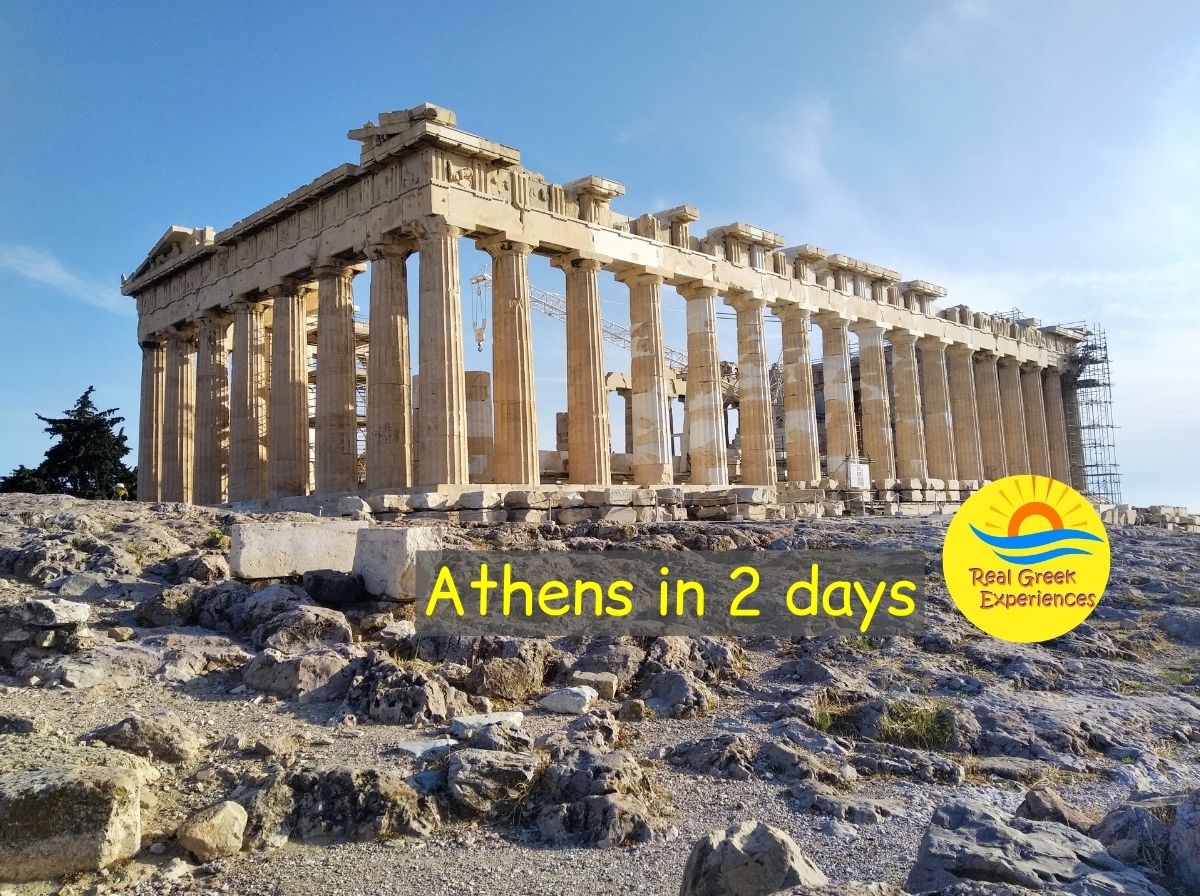
Athens Itinerary For 2 Days
Athens is an ancient city with an incredibly long and varied history. It’s world famous for being the birthplace of democracy, as well as for its archaeological sites and monuments. In addition, visitors rave about the food and the ambiance.
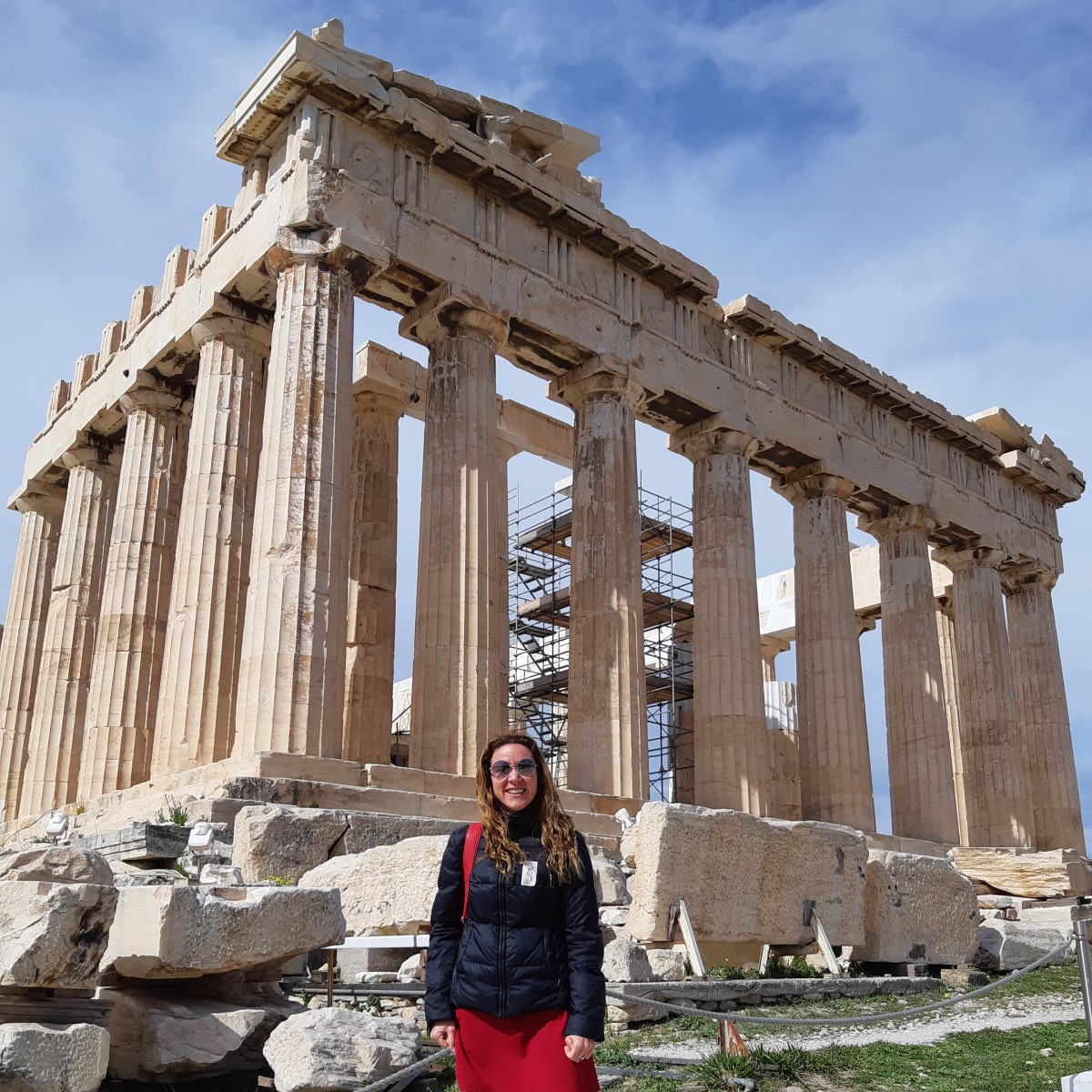
While two days in Athens is not enough to see everything, most of the attractions are in the city center. You will be able to see the Acropolis, the Ancient Agora, the National Gardens, the Acropolis Museum, and much more.
Unless you are planning to take an Ancient Greece guided tour, try to brush up on your Greek history before you visit. A quick history lesson will help you understand why Ancient Athens was so important.
It will probably leave you humbled by what humans were capable of creating during those ancient times!
Bring comfortable shoes, a hat, sunblock and some water. Greece’s climate isn’t always easy on visitors who aren’t used to it!
And now, let’s explore Athens together!
2 days in Athens itinerary – Day One
Day one in Athens includes a mix of ancient sites, museums, traditional architecture, great food and a few other attractions. Here’s our itinerary:
- The Acropolis
- Temple of Olympian Zeus
- Acropolis Museum
- Plaka
- Lunch in Plaka
- Anafiotika
- Roman Agora
- Hadrian’s Library
- Areopagus Hill for sunset
- Dinner and drinks in Monastiraki
Let’s start our two days in Athens itinerary with Greece’s most famous archaeological site: the Acropolis.
The Acropolis of Athens
The ancient citadel of the Acropolis has been a Unesco World Heritage Site since 1987. It is up on a hill, which you can reach through several steps.
There are several noteworthy landmarks inside the complex. The most important sights are the Parthenon Temple, the Erectheion with the Caryatids, the Temple of Athena Nike and the Theatre of Dionysus.
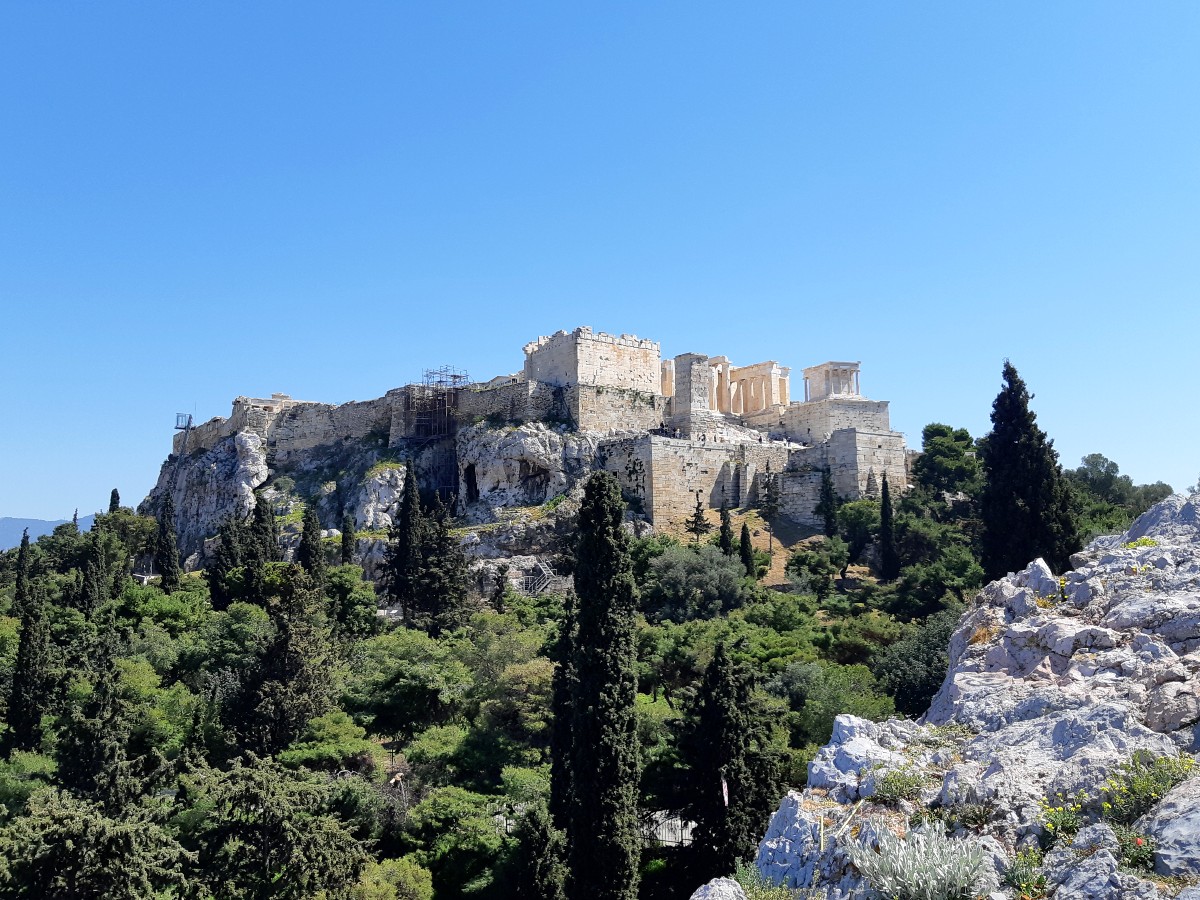
The impressive Gate to the citadel is called Propylaia. Its construction was completed in 432 BC, a few years after the Parthenon.
The Acropolis opens at 8 am year round, and closing time varies by season. Get there early, to avoid not only the summer heat but also the groups of cruise ship passengers.
There are two entrances, and the main one is marked on Google Maps as “Acropolis ticket office“. The other is close to the “Tourist information centre Athens”, a short walk from Acropolis metro station. I prefer to use this one, as it’s normally less crowded.
Tickets are available in advance on the official website.
Allow at least an hour and a half to visit the Acropolis. This will give you time to admire the views from the top of the ancient hill, right under the giant Greek flag.
From up there, you can spot the Temple of Olympian Zeus, the Acropolis museum, and several green spaces, like Filopappou and Lycabettus Hill. Far away in the background, you can see the sea!
Inside the Acropolis: The Parthenon
The Parthenon is one of the most breathtaking temples in the world. It was built between 448 – 438 BC in honour of the Goddess Athena, one of the twelve Olympian Gods.
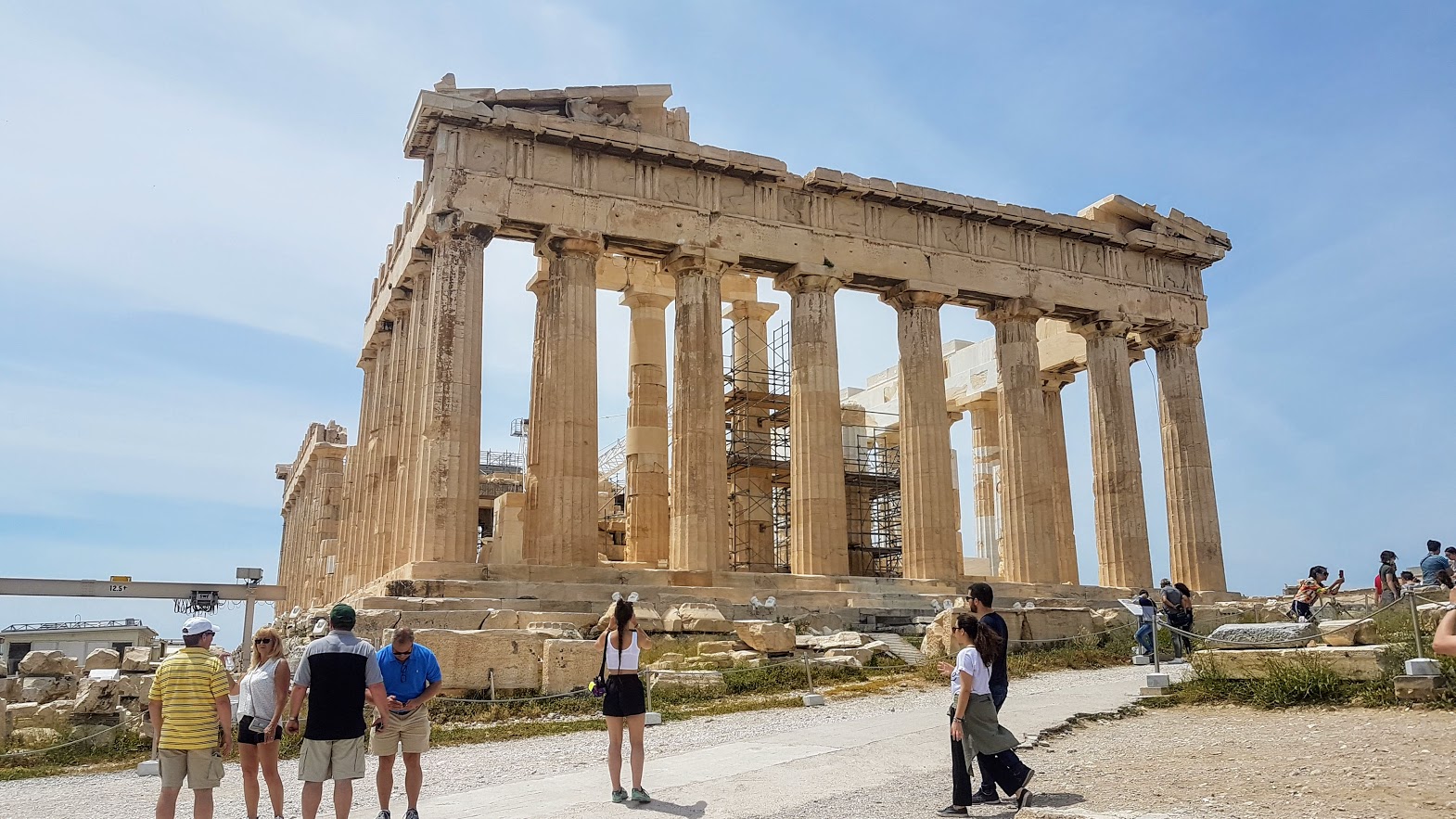
Athena the Virgin was the patron goddess of Athens, and more temples in the ancient citadel were dedicated to her. Here’s a cool story about how Athens got its name!
Apart from the temple of Athena Nike and Erectheion, the remaining temples have not survived.
As Athens was occupied by several conquerors over the centuries, the Parthenon was reconstructed from time to time. Today, visitors can walk around, and observe the fascinating architectural details, representative of Ancient Greece.
Inside the Acropolis: Erechteion
Another iconic temple inside the Acropolis complex is Erectheion. This monument was dedicated to both Athena and Poseidon, the mighty god of the sea. It was constructed between 421 – 406 BC.
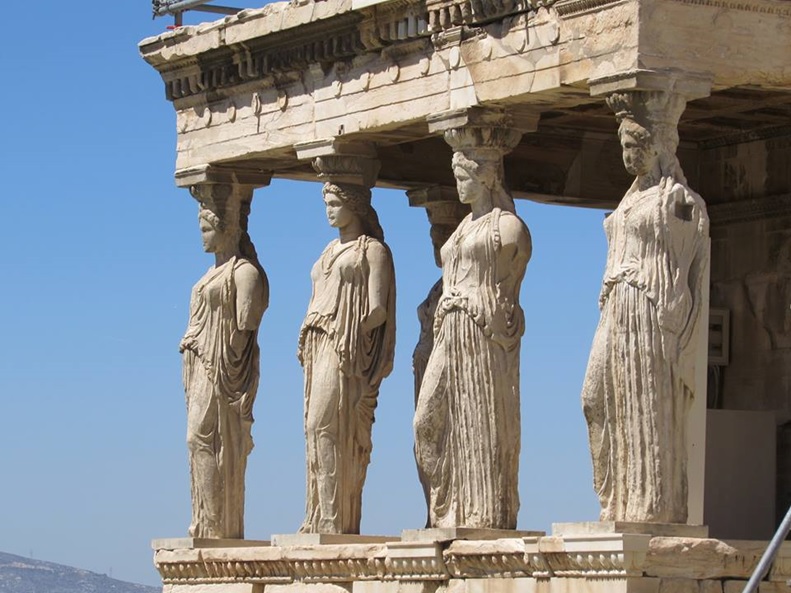
The statues that support the roof are replicas of the world-famous Caryatids. Five of the originals are in the nearby New Acropolis Museum. The sixth can be seen in the British Museum, in London.
Inside the Acropolis: Other important monuments
As you are walking on the hill, you will see many ancient ruins, including two majestic theatres.
The Theatre of Dionysus is a short walk from one of the entrances to the Acropolis. It was constructed to honour the God Dionysus and hosted performances by the most famous Ancient Greek tragedians, like Euripides and Sophocles.
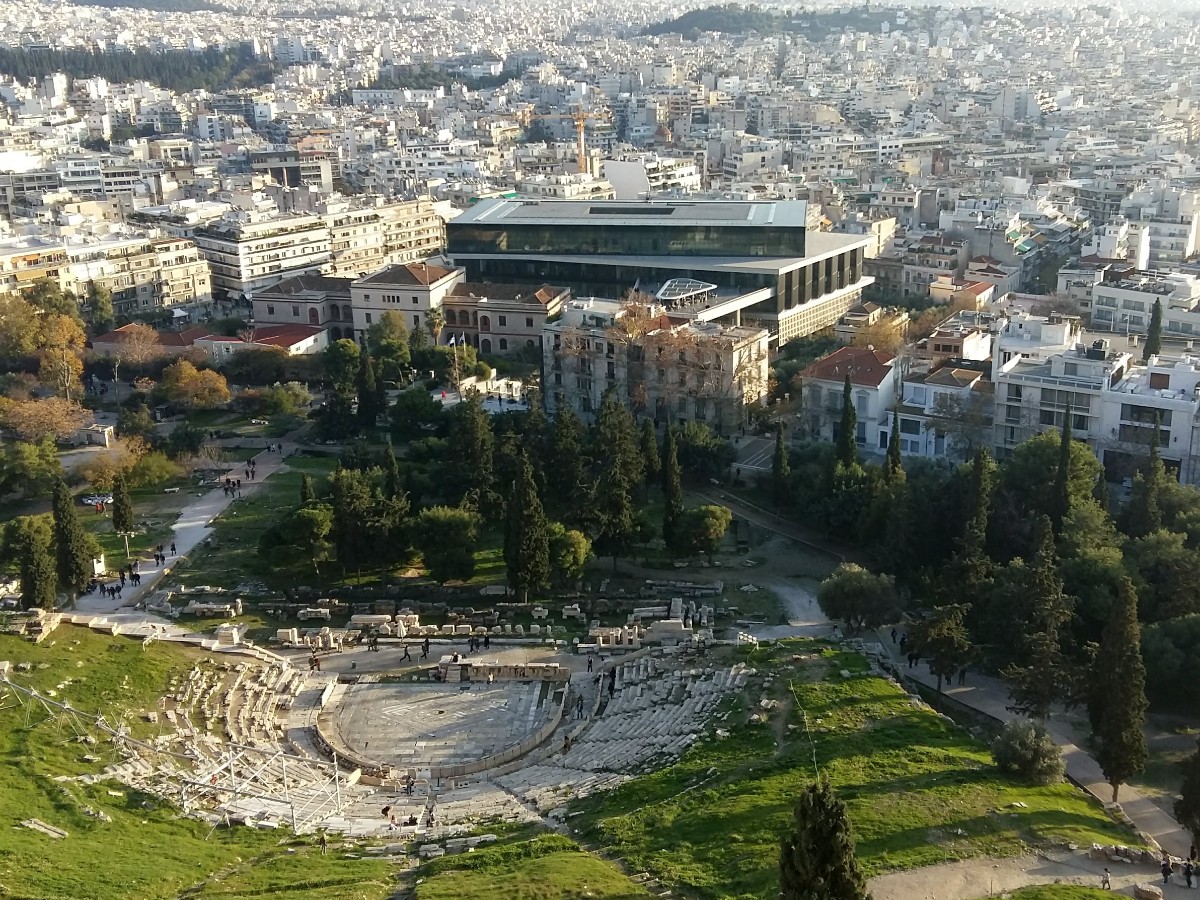
The Odeon of Herodes Atticus was built several centuries later by a wealthy Roman philosopher, Herodes Atticus. You can see it from above when you are inside the Acropolis.
In summer, the Odeon of Herodes hosts theatrical performances and concerts under the starry sky. It is one of the most unforgettable experiences you can have in Greece, so look out for any events!
You can read more about Ancient Greek theatres in this article.
Next stop on our Athens Itinerary: Temple of Olympian Zeus
After leaving the Acropolis, you can visit the temple of Olympian Zeus, which is only a short walk away.
The temple of Olympian Zeus was the biggest temple of the Greek ancient world, and was fit for the King of Gods. Its construction was completed during the reign of the Roman Emperor Hadrian, in 132 AD.
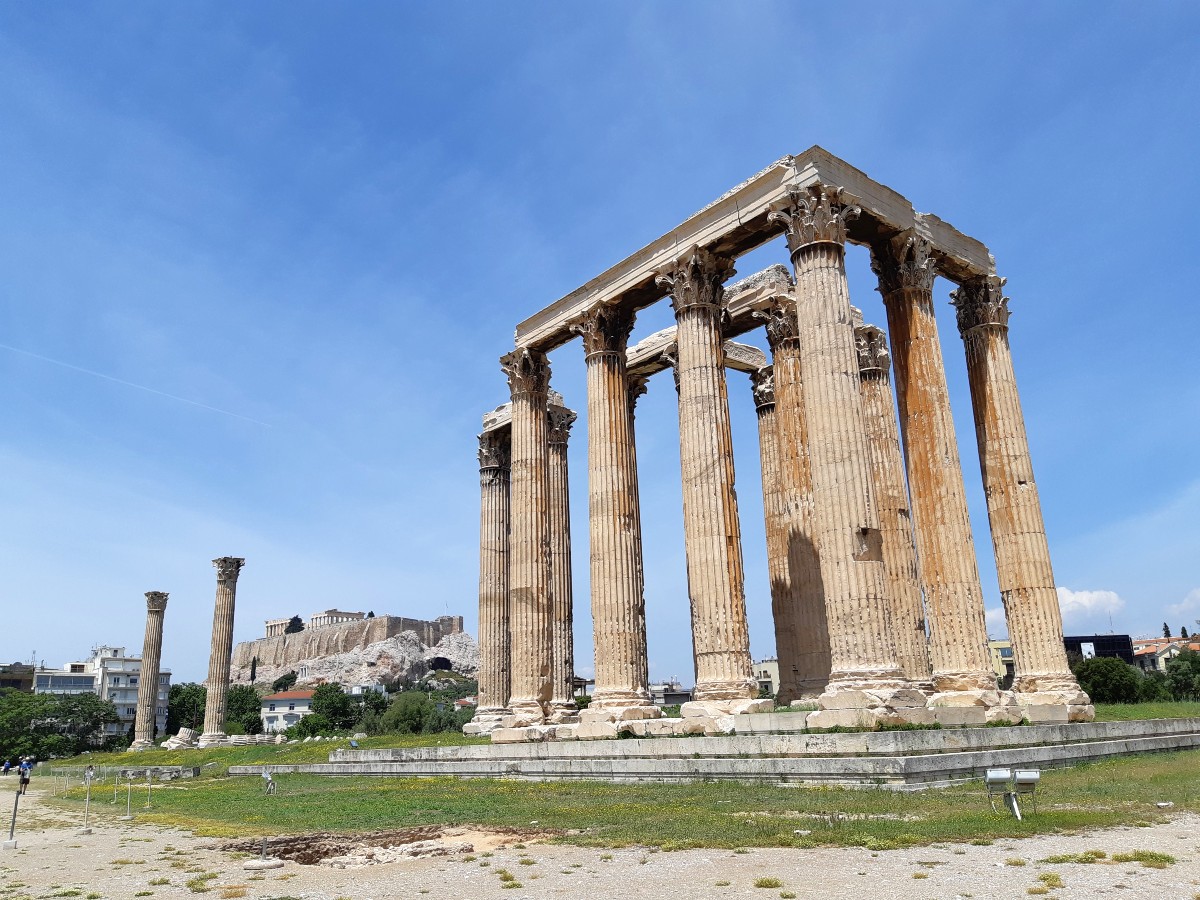
He admired the Greek civilization, and built several important monuments around the city, including Hadrian’s Library.
When it was completed, the temple consisted of 104 columns, out of which only 15 remain today. Their size is really mind-blowing! There are a few more ancient ruins all around the site, but all in all you probably need under an hour here.
On your way out, make a quick stop to check Hadrian’s Arch. This massive gate was built in honour of the Roman Emperor in 131 AD.
Explore the Acropolis Museum
After visiting the two ancient sites, you’ll probably be warm! It’s time to explore the fully air-conditioned New Acropolis Museum, which opened its doors in 2009.
It’s dedicated exclusively to ancient artefacts that were excavated around the Parthenon and the Acropolis.
You will see several statues, vases and everyday objects. The most impressive statues are the five original Caryatids, that were brought in from the Erectheion for protection.
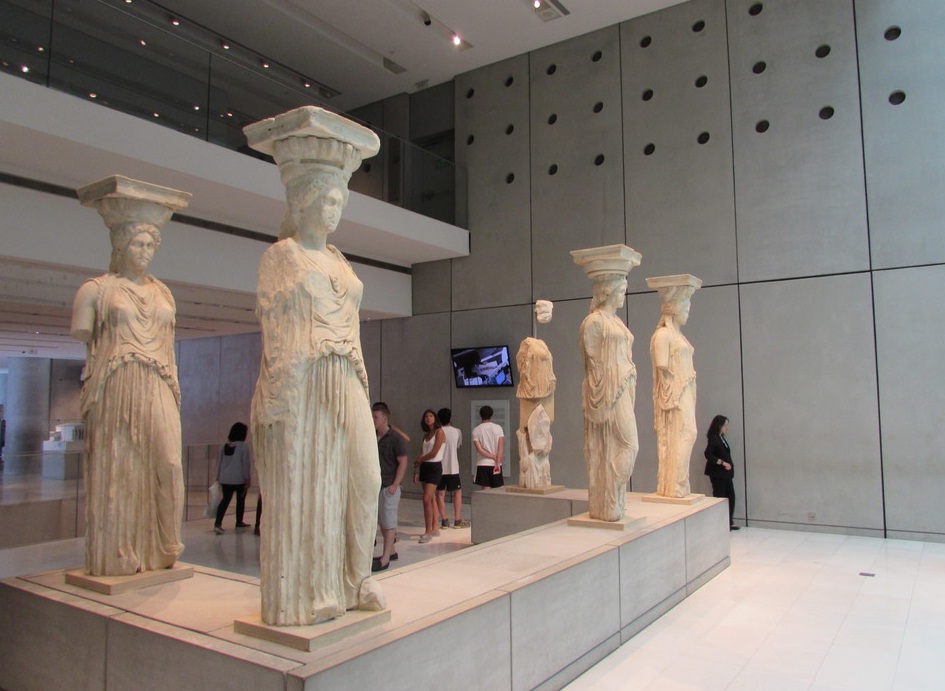
Notice that they are not symmetrically placed, but there is space for a sixth statue. Greek archaeologists hope that, one day, it will return from the British Museum.
On the top floor, the surviving sculptures from the Parthenon’s frieze are exhibited. If you look closely, you will realize that many of them are replicas – the originals are in world class museums in several countries.
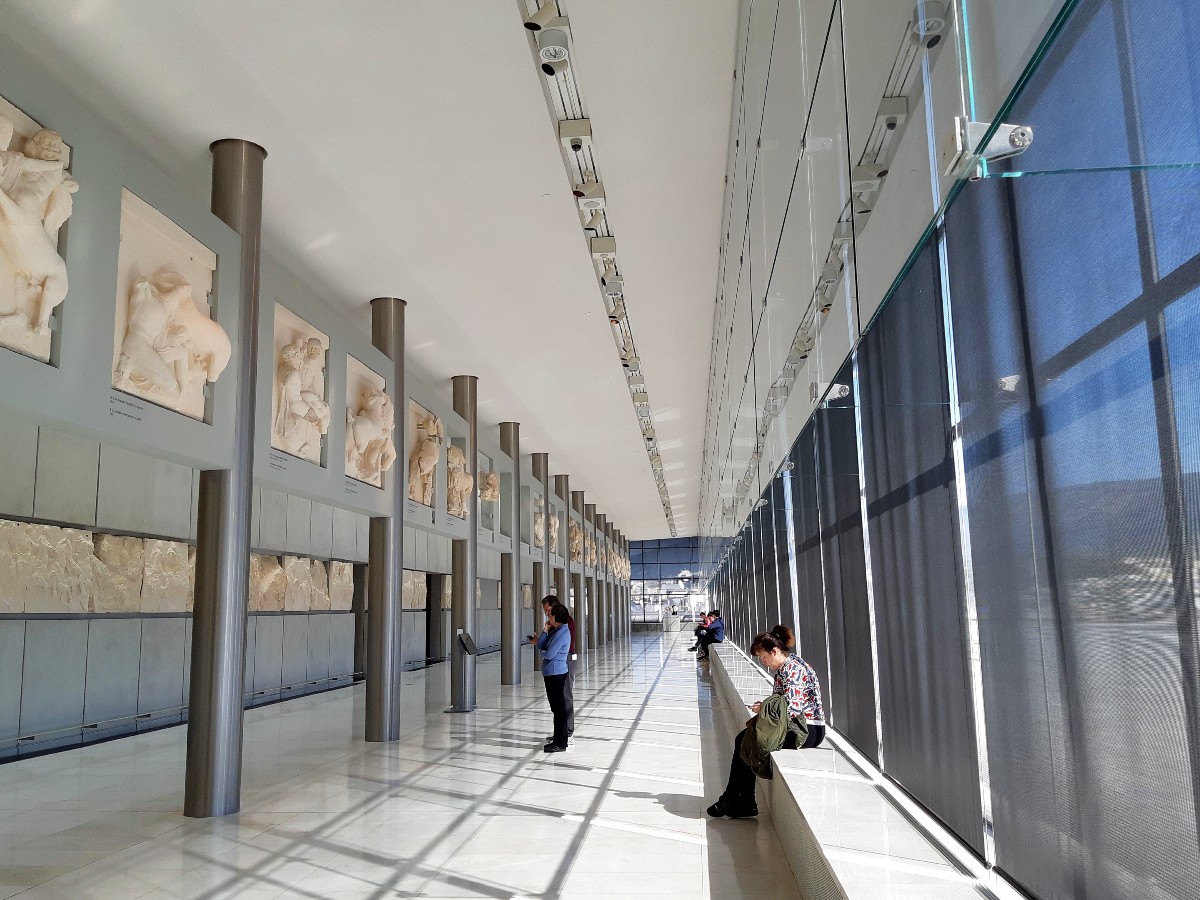
Apart from the exhibits themselves, take some time to admire the unique architecture. The large windows allow for plenty of sunlight, with a incredible view of the Parthenon.
In addition, the Acropolis cafe is a good place for a break. Few cafes in Athens can boast this view!
On your way out, don’t miss the newly opened area at the basement. Several houses of the ancient city have been excavated literally underneath the archaeological museum.
Stroll around Plaka
And now, time for lunch! Plaka is one of the oldest and possibly the most picturesque neighborhoods in Athens. While there is a touristy element, it’s nevertheless a charming, quaint little area.
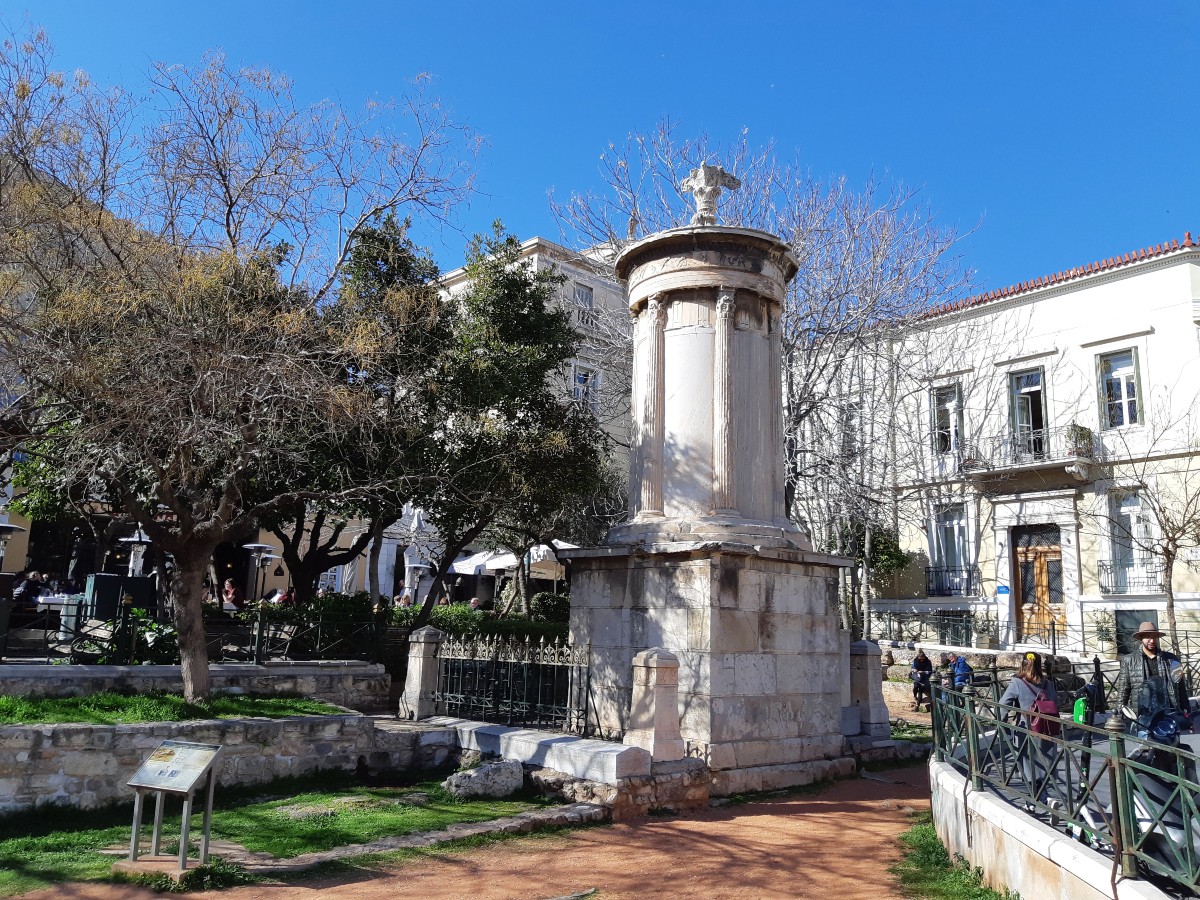
The best way to explore Plaka is to walk around its cobblestone alleys. You will see traditional Greek architecture and colorful houses scattered around narrow streets, along with some interesting street art.
Along the little alleyways, you will find numerous souvenir shops, selling all sorts of stuff. This includes Greek sandals, leather goods, silver jewelry, carpets, fur coats and cheap souvenirs.
Here’s some more info on the best souvenirs you can get in Greece.
Plaka is home to a few small museums and galleries. People with only 2 days in Athens normally skip them, which is a shame as some of them are really cool. Here are all the museums in Plaka.
There are also plenty of cafes and restaurants, some of which have been around for many decades. Which brings us to the important question: Where to have lunch in Plaka?
Lunch in Plaka
It is clear by now that Plaka is a somewhat touristy area. However, this doesn’t mean that Greeks don’t hang out here! Here are a few places to eat in Plaka that I can recommend based on my experience.
Tavernas in Plaka
Evgenia at Voulis 44A – My favourite no-frills taverna in Plaka, serving hearty, traditional Greek dishes. They are very popular with locals and visitors, so the food is always fresh. I’m always happy with a Greek salad and the fish / seafood dish of the day!

Scholarchio at Tripodon 14 – An ouzeri established in the 1930s. They bring you a selection of Greek dishes in a tray, and you can choose the one you like the looks of 🙂 I’ve been coming here for almost 3 decades now!
To Kafeneio at Epiharmou 1 – Right next door from Scholarchio, they serve tasty Greek food including some interesting salads.
Platanos at Diogenous 4 – An old-style taverna with decent food and a lovely shaded courtyard. You can go inside and check the dishes if you want. On your way out, you can pass by the fascinating Museum of Greek Folk Musical Instruments, my favourite museum in Plaka.
Before you go to any of these tavernas, check out my list of 50 popular Greek dishes, and see if you can identify any!
Coffee / snacks in Plaka
If you are not interested in a proper lunch, here are a few more suggestions:
O Glykys (the Sweet) at Geronta 2 – Small plates in a lovely semi-hidden courtyard. They have a good selection of dishes with meat and cheese, and a few Greek drinks like raki and ouzo.
Yiasemi at Mnisikleous 23 – Come here for a light lunch, quick snack, coffee, drink or their amazing desserts. In fact, you will be lucky if you can get a seat here, as it’s always popular. There’s a rooftop area as well.
Melina Cafe at Lissiou 22 – A cozy all-day cafe / bistro, dedicated to the memory of the unforgettable Melina Mercouri.
Climb up the quaint district of Anafiotika
Just above Plaka, there is a small, quaint area called Anafiotika. Here, you can see some of the oldest houses in Athens. They were built by workers who came to Athens from the Greek islands in the 1830s, after the Greek Independence War.
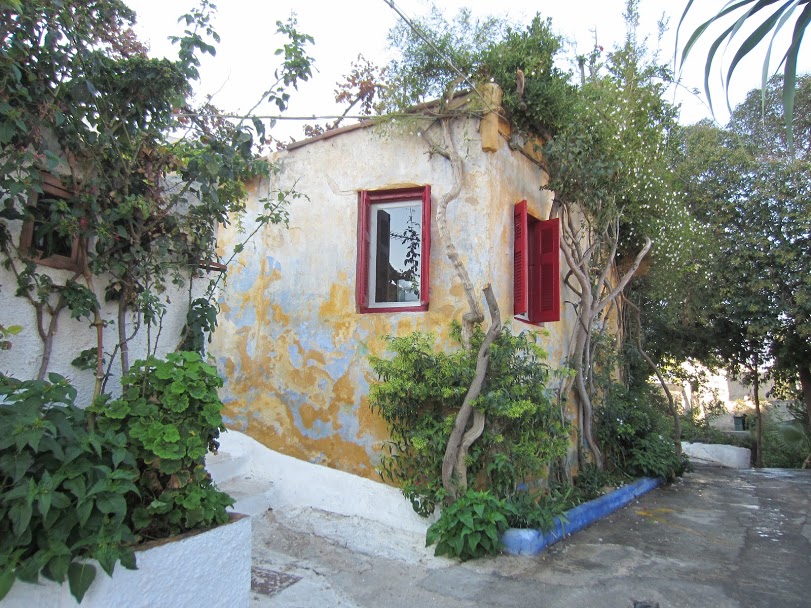
This is the most unexpected district right in the historic center. You will be totally blown away by the quaint architecture and also the cool street art. As you are walking around the picturesque streets, please respect the residents.
Here is some more information about Anafiotika.
Drop by the Roman Agora and Hadrian’s Library
After leaving Anafiotika, you can easily pop by the Roman Agora, located close to Monastiraki Square. This is a small archaeological site which is mostly famous for the Tower of the Winds, known as the world’s first meteorological station.
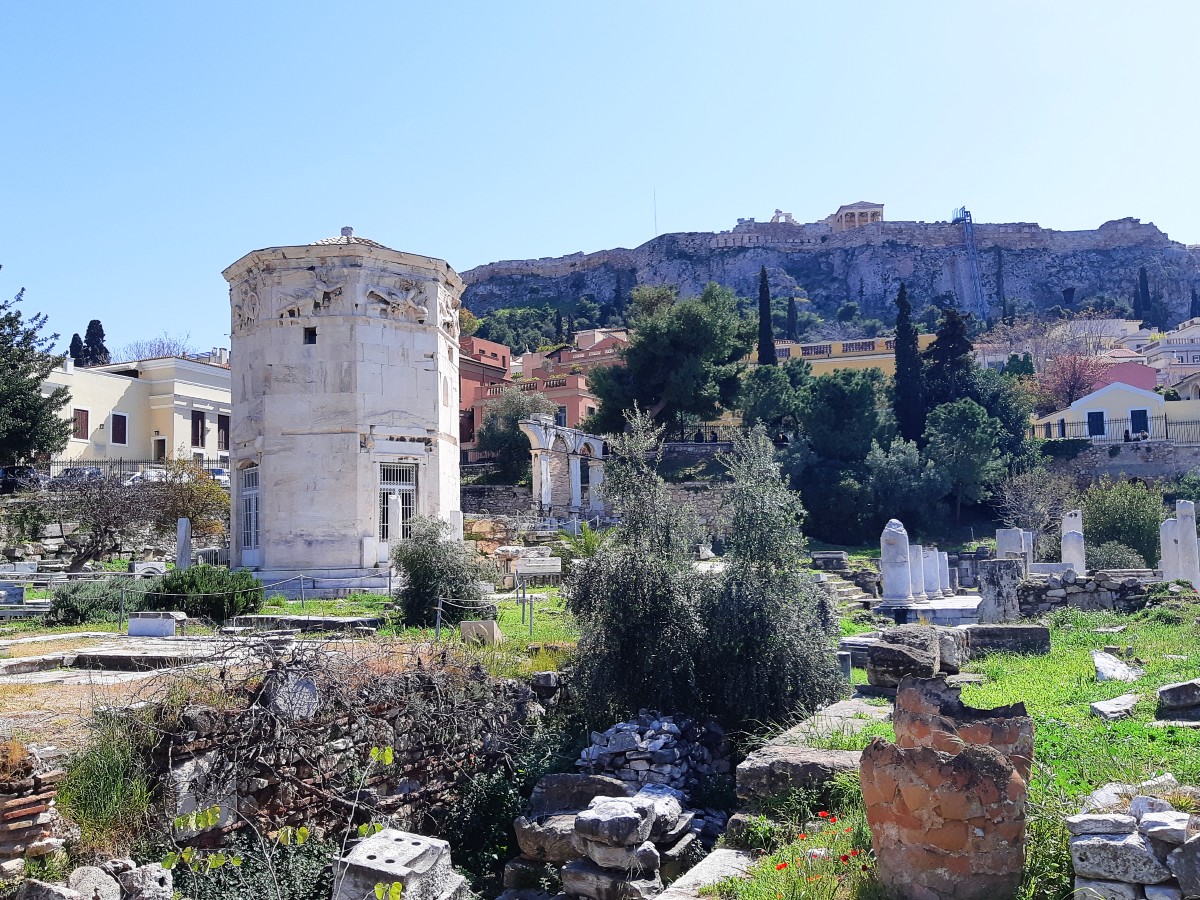
The Roman Agora was the main market area in Athens during the Roman Era. It gradually replaced the Ancient Agora, which had been the main market for several centuries.
The new market was lavish, which is apparent if we look at the impressive gate.
Hadrian’s Library, just next door, is one of the least visited sites in Athens. Unfortunately, there isn’t much left to see of the once majestic library, which measured about 120 x 80 metres.
It contained historic and literary books, and also the city’s archives and records.
Head up Areopagus Hill for the sunset
After all this walking, you might just want to put your feet up and relax! A short walk from Hadrian’s library is Areopagus Hill, a large rock with fantastic views of the capital.
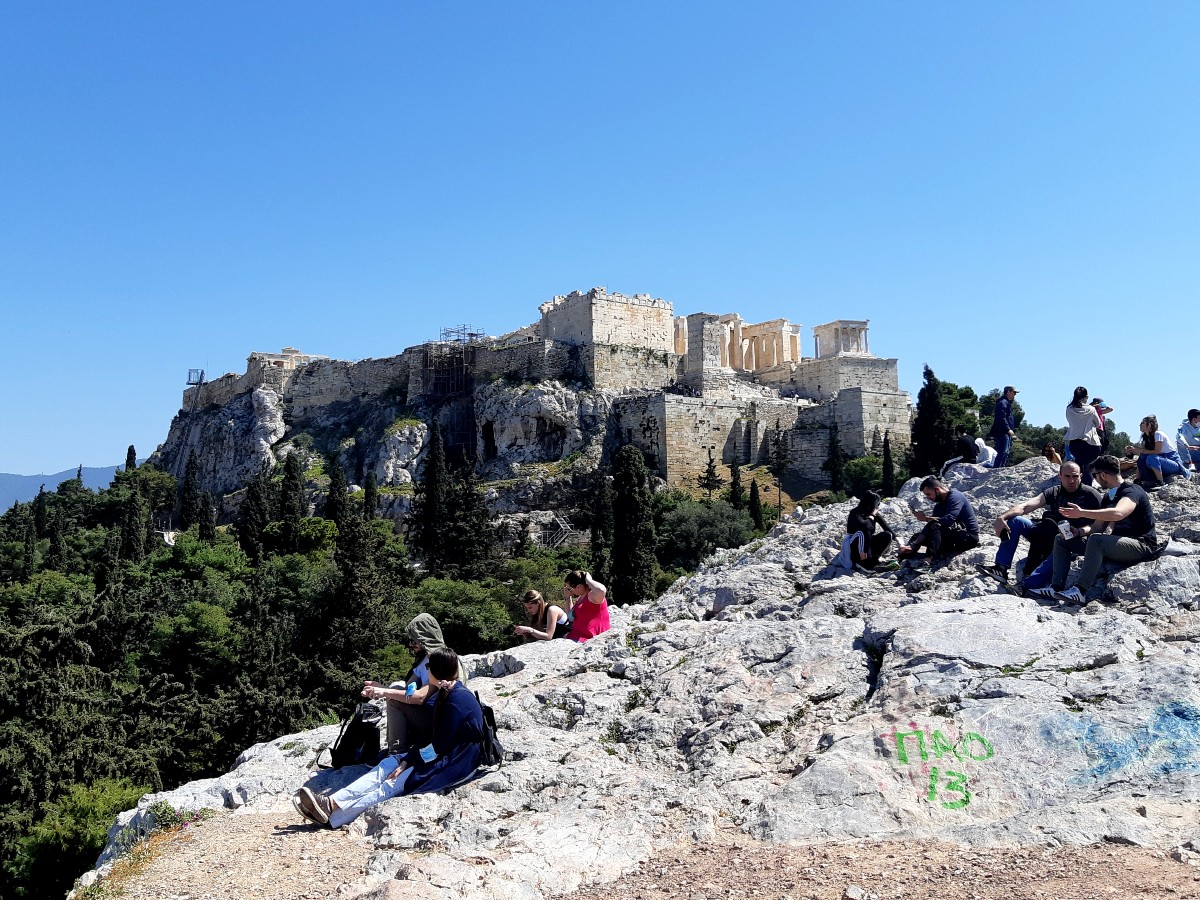
Areopagus, known in Greek as Areios Pagos, was an important court in Ancient Athens. It’s also the place where Apostle Paul delivered his speech on Orthodoxy, in 51 AD.
The Rock is one of my favourite spots, and I would include it in any Athens itinerary. It’s a popular spot to see the sunset from, and you will get beautiful views of the Acropolis when the lights come on.
Here is some more information about Areopagus Hill in Athens Greece.
Dinner and drinks at Monastiraki Square
Your Athens itinerary wouldn’t be complete without a dinner, or some evening drinks! Two popular rooftop bars overlooking Monastiraki Square are A for Athens and 360.
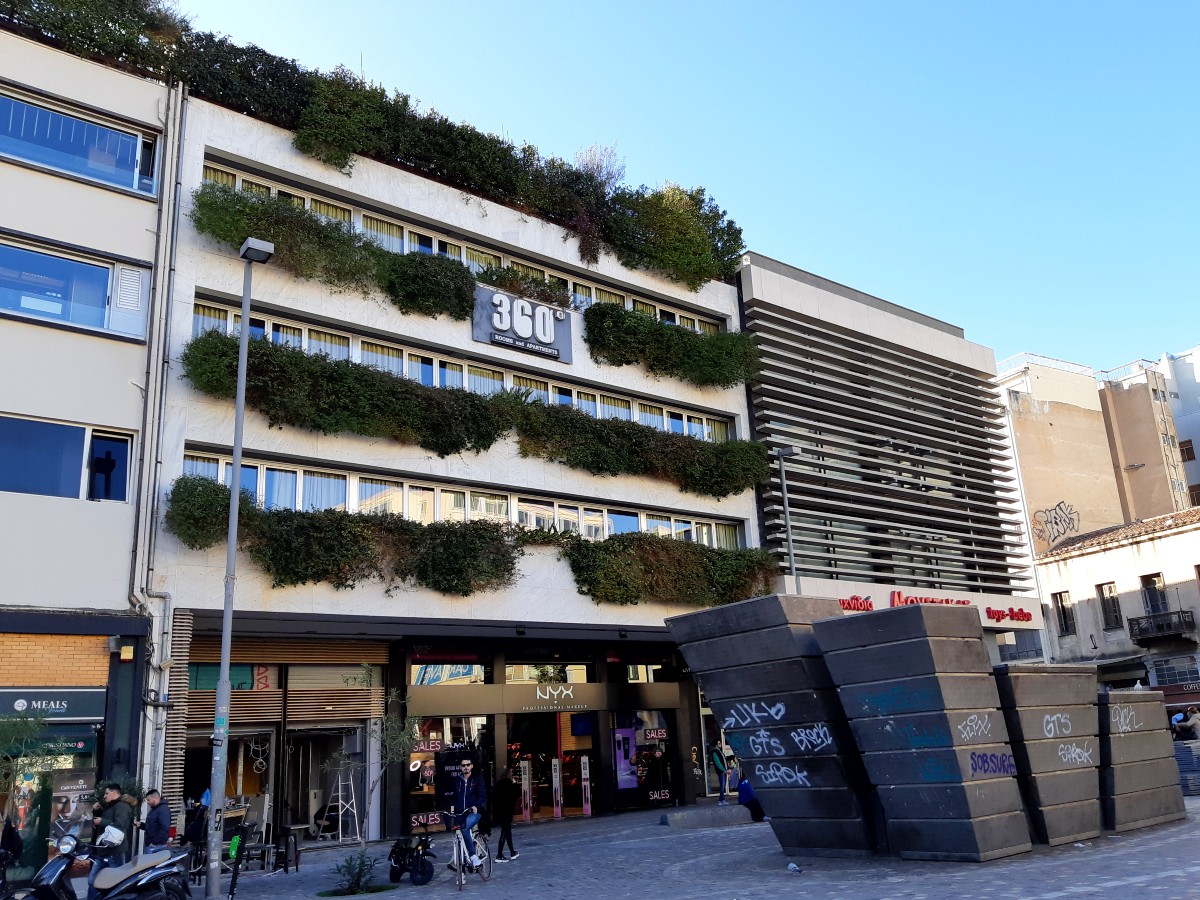
These two bars have some of the best Acropolis views, and you will absolutely enjoy your night out in Athens!
2 days in Athens itinerary – Day Two
Our day two in Athens includes some more sightseeing. We will also explore a more authentic side of the city, including its vibrant markets. Here’s our Athens itinerary:
- Panathenaic Stadium
- National Gardens
- Syntagma Square
- Changing of the Guards
- Walking down Ermou street
- Athens food market
- Psiri area
- Lunch at Psiri
- Monastiraki Flea Market
- Ancient Agora
- Your choice!
Visit the Panathenaic Stadium
Start your day at the impressive Panathenaic Stadium. This amazing ancient site was built in around 330 BC, to host the Great Panathenaia. At the time, it was the most important athletic and cultural event in Athens.
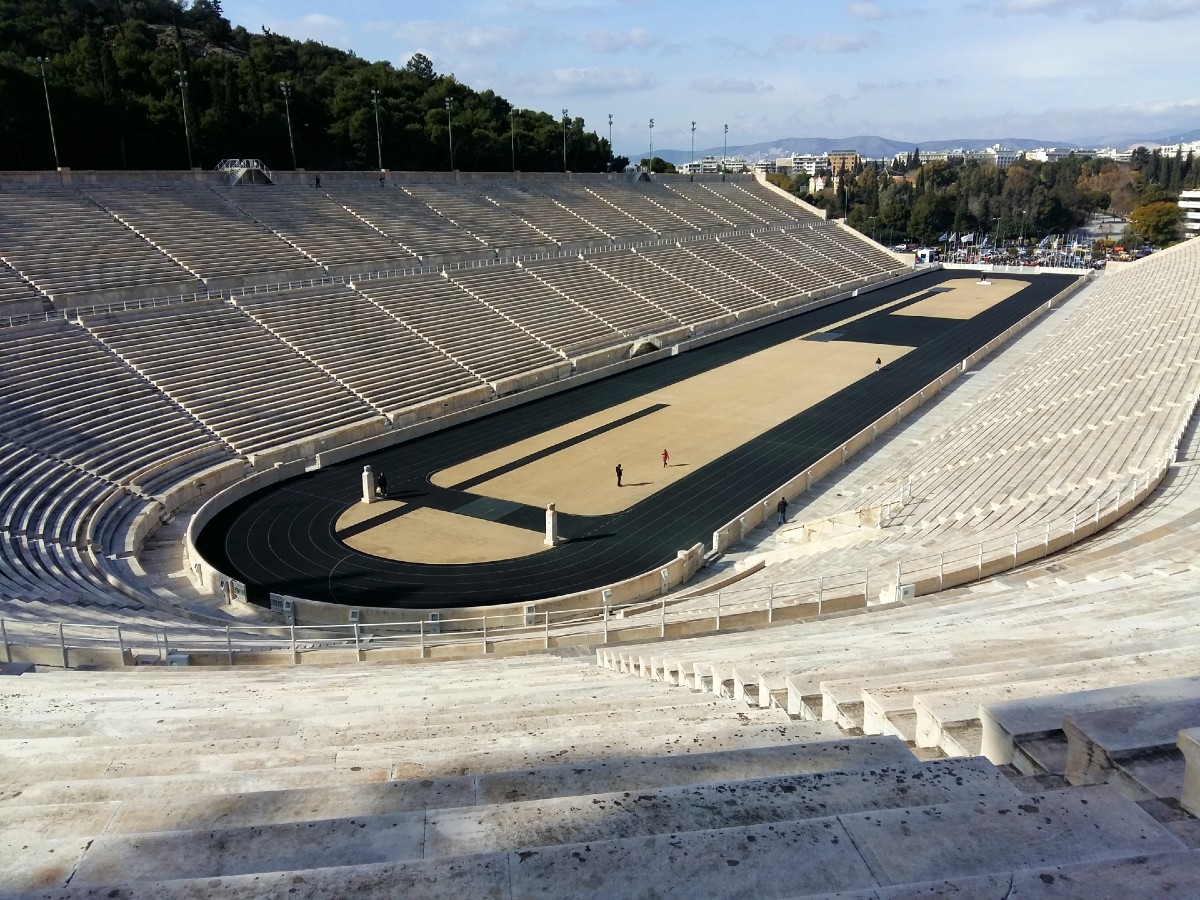
Over the centuries, the stadium was gradually abandoned. In the late 19th century, certain people came up with the idea of reviving the Ancient Greek Olympics.
The Panathenaic Stadium was chosen to host the first modern Olympic Games. It was fully restored, and has been used ever since to host numerous events.
While you can have a glimpse of the stadium from the outside, I absolutely suggest you go in. You can’t appreciate its size unless you walk up the stairs! There’s also a small but interesting museum with the history of the Olympic Games.
Here is some more info about the Panathenaic Stadium.
National Garden in Athens
Our Athens itinerary continues through the National Gardens. This is a beautiful park, which was designed by Queen Amalia. She was the wife of King Otto, the first king of Greece after the Independence War.
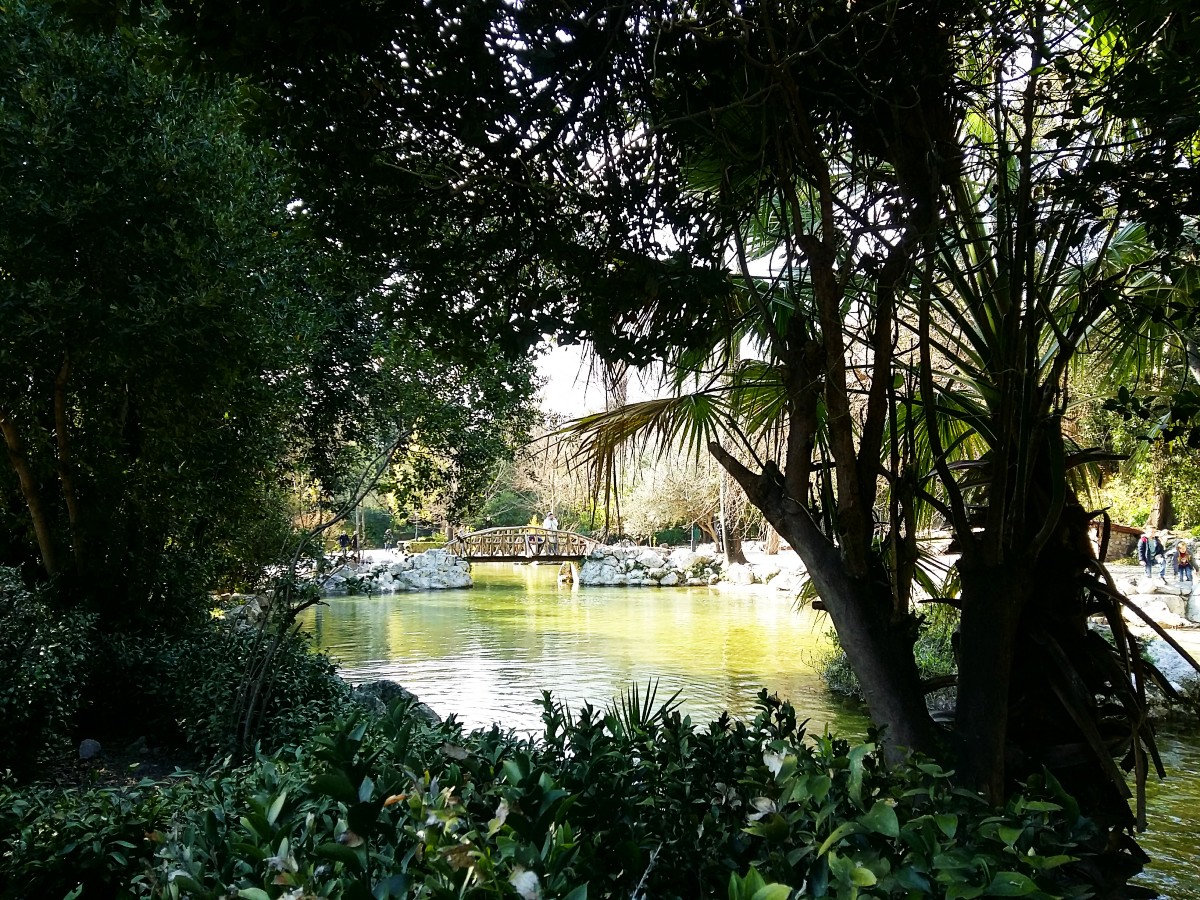
The gardens are a popular retreat from the hustle and bustle of the city center. You will see hundreds of different types of trees, bushes and flowers.
There are also a couple of ponds, and if you look carefully you will spot a few ancient ruins and an impressive mosaic.
Here is my article on the National Garden.
Check out Syntagma Square
After strolling through the Gardens, you will arrive at Syntagma Square, the most central point in Athens. The first thing you will see is the impressive Greek Parliament building.
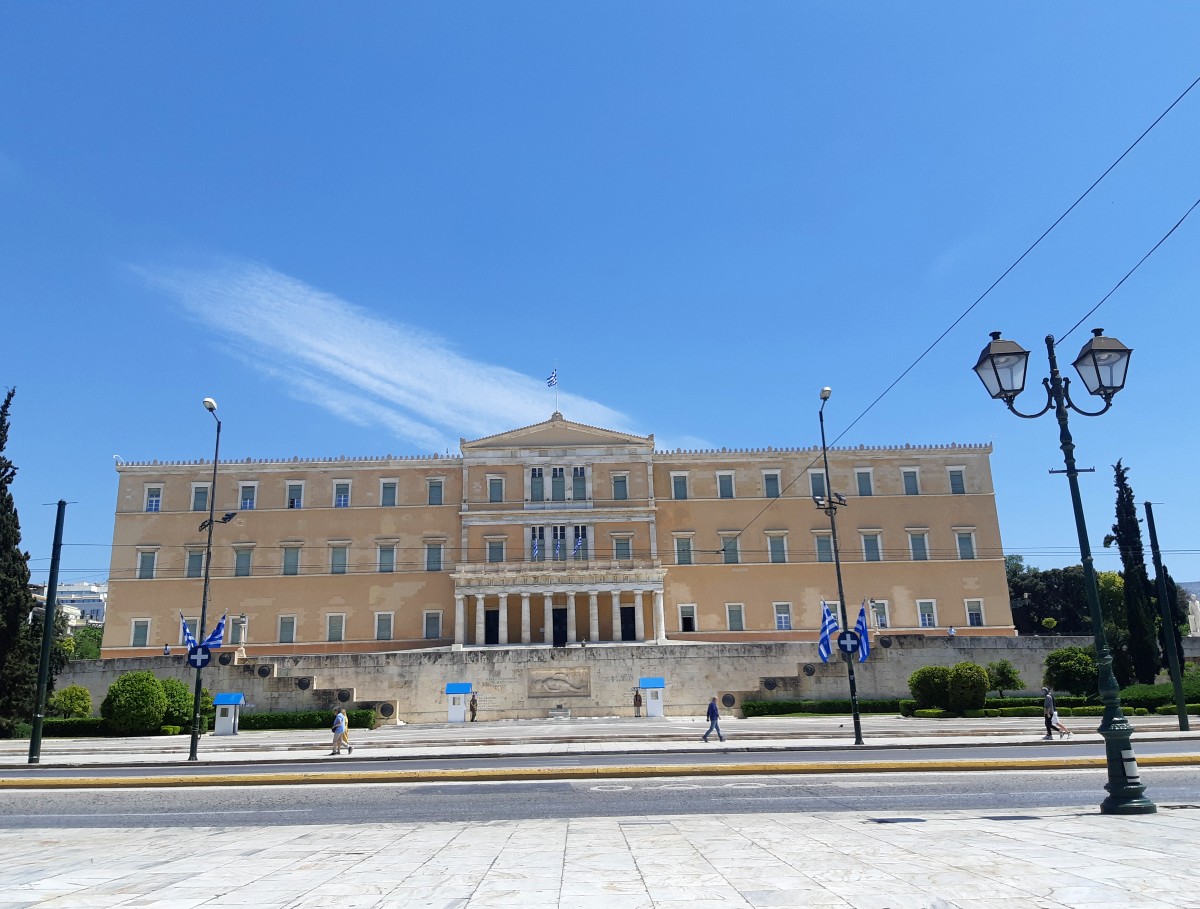
This neo classical building was once the Palace of King Otto and Amalia. Since 1935, it has been hosting the Greek Parliament. It is possible to pay a visit, but you need to pre-book it well in advance.
All around Syntagma Square, you will see more interesting buildings, like the Grande Bretagne Hotel.
Here’s some more information on Syntagma Square, and why it’s so important for Athenians.
Watch the Changing of the Guards
No Athens itinerary is complete without watching the Changing of the Guards! This famous ceremonial walk happens every hour on the hour and is a great photo opportunity.
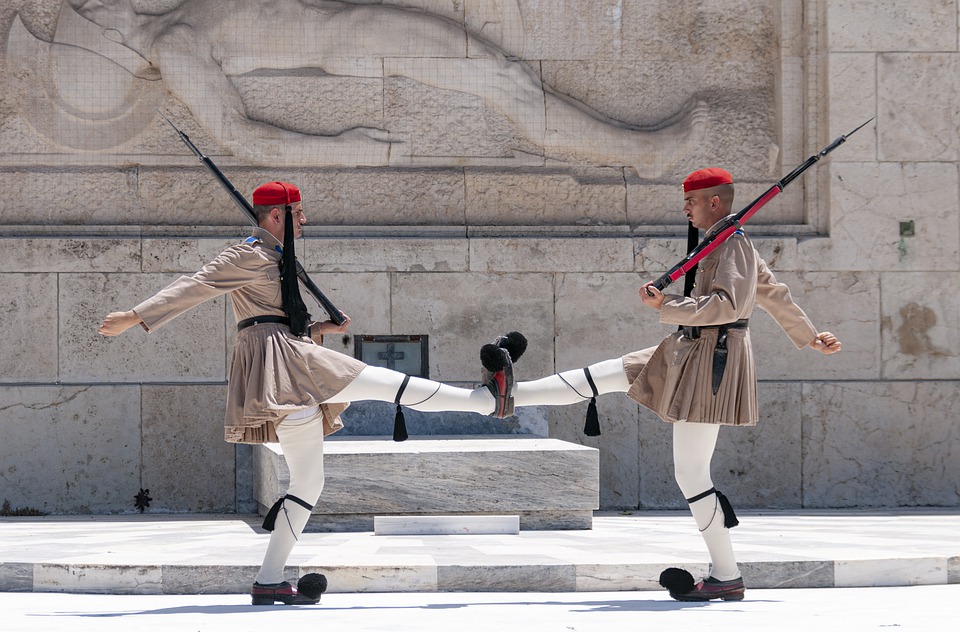
The Changing of the Guard takes place by the Tomb of the Unknown Soldier, right in front of the Greek Parliament. This solemn monument is dedicated to every unknown soldier who died during Greece’s numerous wars.
The Guards, or Evzones in Greek, are specially selected soldiers serving in the Greek Army. Their walk has numerous symbolisms, which is why the ceremony is an almost sacred event.
You can read more about the Changing of the Guards here.
Head down Ermou Street
Cross the street from the Greek Parliament building, and you will be right on the main shopping street in Athens, Ermou street.

This is a pedestrianized street with shops on either side. It’s perfect for shopping, window-shopping or just people watching. You will see international and local stores with shoes, clothes, jewelry and homeware.
The sidestreets are also great if you are looking for items like beads, fabrics, and art / craft materials.
As you are walking down Ermou, you will see a Byzantine church named Kapnikarea. It was built in the 11th century, and contains some impressive frescoes designed by Fotis Kontoglou, a famous Greek artist.
All around Ermou, there are dozens of cafes, bakeries, and places to grab a quick snack.
Check out this guide on where to go shopping in Athens for more information!
Athens Food Market
And now one of my favourite places in Athens: the Varvakios food market! This is a large food market close to Monastiraki Square, spread across Athinas street and the side streets.

The market has several different sections, some of which are covered. You can find many Greek products, like cheese, cured meats, olives, yoghurt, nuts and bakery snacks. Most visitors are really impressed with the meat and fish section.
I come here a few times a month to do some food shopping. Despite the fact that it’s becoming a popular Athens attraction, I am glad that the market still remains authentic.
Many of the market stalls start closing at around 15.00, and the market is closed on Sundays. Here’s some more information on the Varvakios central food market.
Tip: If you take an Athens food tour, it will likely include the food market.
Psiri area
Right next door from Varvakios market, you will find the quirky Psiri area. It’s a tiny neighbourhood full of all-day cafe – bars, dozens of places to get a snack or dessert. The iconic Little Kook cafe is right here.
Psiri is also one of the best areas in Athens to explore if you are into street art.
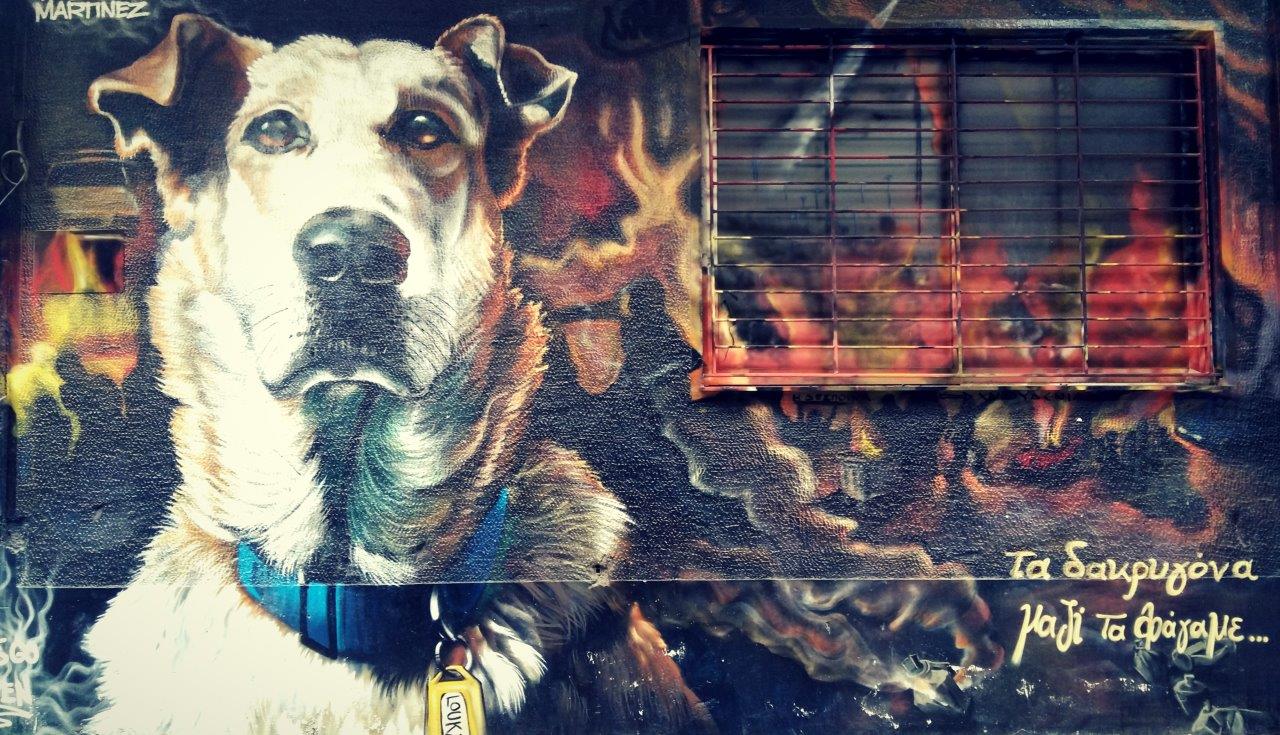
You don’t need too long to stroll around the small area – after all, it’s time for lunch! You can read more about Psiri in Athens here.
Lunch at Psiri
Psiri is one of my favourite districts in central Athens for food. While it’s more popular with tourists than it was 10 years ago, it offers a great choice for authentic tavernas with delicious food. Here are some suggestions:
Mavros Gatos at Navarchou Apostoli 5 – My favourite restaurant in the city center. They normally open at lunchtime around 13.00ish, and serve a fantastic selection of small Greek dishes and drinks! I love everything, especially the chicken with peppers and the strapatsada omelette. At the end, you get a treat 🙂
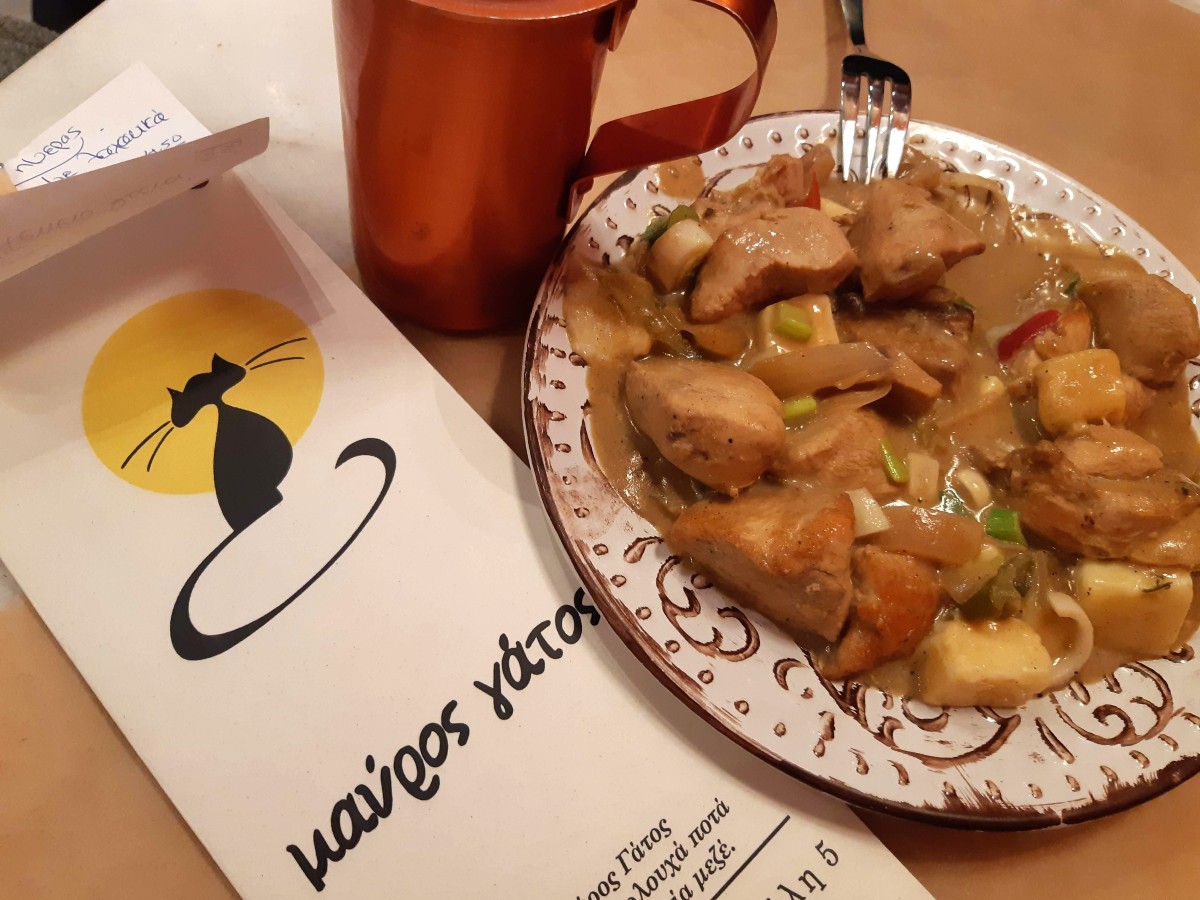
Atlantikos at Avliton 7 – A somewhat hidden spot for fish and seafood. Anything I’ve tried here is great, as long as you like fish! If you are not sure what to get, go for the platter, along with some raki.
Pame Naxo at Navarchou Apostoli 5 – If you can’t get a seat at Mavros Gatos, Pame Naxo is a pretty good option. Naxos is famous for its cheeses and meats, so it’s a good place to taste some.
Minibar at Navarchou Apostoli 16 – Yet another tiny restaurant. They serve small dishes based on traditional recipes with a twist. Check out the specials of the day.
Monastiraki Flea Market
After lunch, it’s time to explore Monastiraki Flea Market. This spreads around Monastiraki Square, and you will find several stores on Ifestou street and the side streets.

You can find clothes, shoes, beads, souvenirs, jewelry, and leather goods. This is also the place to head to for antiques, used books, vinyl records, camping gear, and many other products.
Serious shoppers should consider visiting Athens on a Sunday, when the flea market expands and more antiques stalls appear.
Explore the Ancient Agora of Athens
A few steps from Monastiraki flea market, you will find one of my favourite ancient sites in Athens, the Ancient Agora.
In antiquity, this was one of the most important spots of Athenian life. Since the 6th century BC, it was the place where everything happened – shopping, meeting friends, hanging out.
Famous Greek philosophers like Socrates and Plato walked around the Ancient Agora thousands of years ago.
Among the various ruins, you will see the impressive Temple of Hephaestus. It was completed in 415 BC, and is one of the best preserved ancient temples in Greece.
You will also come across the Byzantine church of Agioi Apostoloi, built in the late 10th century AD.

The Ancient Agora was gradually replaced by the much newer Roman Agora. By the Middle Ages, the site had partly been buried under debris. Over the centuries, several houses were built on top of the ancient ruins.
During the first excavations, in the early 20th century, over 400 buildings were demolished to reveal the magnificent ancient site.
The Ancient Agora is a large area, so it may take you a good couple of hours to explore it properly. Allow enough time for the Museum of the Ancient Agora, which gives a fantastic overview of life in Ancient Athens.
Tip: In modern Greek, the word “Agora” literally means a marketplace. In ancient Greek, it also indicates a gathering, a speech, and a place to gather and discuss!
Here is some more information about the Ancient Agora in Athens.
Free time – Your choice!
Your 2 days in Athens isn’t over yet! There is still enough time for at least one more attraction. Exactly what you want to see is up to you! Here are a few more ideas:
Kerameikos Ancient Cemetery – A stone’s throw from the Ancient Agora, Kerameikos is often overlooked by visitors. Yet, its significance during ancient times was huge.
The National Archaeological Museum – The largest archaeological museum in Greece hosts an outstanding collection presenting the Ancient world. In my opinion, history buffs should prioritize this over the Acropolis Museum. Only drawback – it’s huge, so you’d need about 4 hours to see it properly! Closest metro station: Victoria
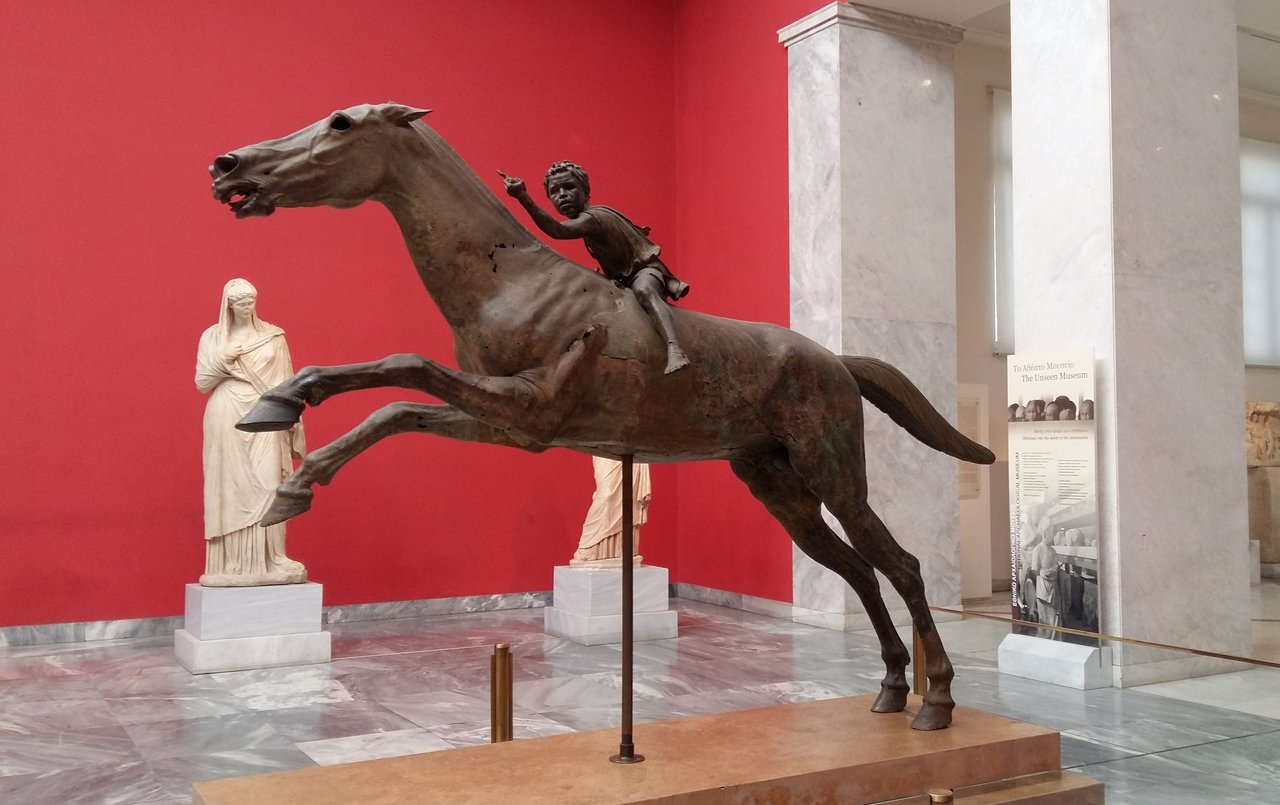
Benaki Museum – The main Benaki Museum in Kolonaki area presents all of Greece’s long history in just one building. It’s perfect if you want a quick introduction to Classical, Roman, Byzantine and modern Athens and Greece. Closest metro station: Evangelismos
Lycabettus Hill – A lovely viewing spot, particularly popular for sunset. You can either walk up, or take the funicular car / a taxi. It’s walking distance from the Benaki Museum.
Art Galleries in Athens – Visitors don’t always connect Athens with modern and contemporary art. The truth is, we have many major art museums and galleries, and it would take well over 2 days in Athens to see them all! I would strongly suggest the newly opened National Gallery, or the Benaki Museum, Pireos 138 branch.
Temple of Poseidon at Sounion – If you have an afternoon and evening free, I highly recommend taking a sunset tour to the Temple of Poseidon at Sounion.
FAQs about Athens and Greece
And now that we’ve seen what to do in 2 days in Athens, here are some answers to FAQs:
What is the best time to visit Athens?
I would recommend visiting Athens during the shoulder season. Summer can be too hot and crowded! Late spring is my favourite time in Athens, as all the flowers up on the hills are blooming.

Here is some more info on the best time to visit Greece.
How can I get to the city centre from the Athens international airport?
I always use public transport from the Athens airport. There are three choices: the airport metro, the suburban railway and the airport bus.

The metro and suburban railway cost 9 euro. The airport metro system is very easy to navigate, and you can get the blue line directly to the centre. All in all, it’s the easiest option.
Do watch out for pickpockets, as I’ve heard of some incidents. Here’s my guide on how to avoid pickpockets in Athens.
The Athens airport bus is the best budget option, as it only costs 5.5 euro per person. X95 bus terminates at Syntagma Square. If you are staying in Plaka or Koukaki you will have to walk or take a short taxi / metro ride.
A taxi normally costs 40 euro during the day (or a little more for a pre-booked service), and 55 euro from midnight to 5 am.
If you are staying close to the Acropolis, here are all the ways to get to your hotel from the airport.
What’s the best way to get around the city centre?
People who like walking could do most of the above Athens itinerary on foot. To reach the National Archaeological Museum or the Benaki Museum, you could consider using the Athens metro system, or a taxi.
Here are all the ways to get around Athens.
What’s the best area to stay in Athens?
Since you only have 2 days in Athens, I would suggest that you stay in either Plaka or Koukaki. Other areas I like include Thissio, Monastiraki and Psiri.
Do I need travel insurance to visit Greece?
Taking travel insurance is never a bad idea, especially if you are coming from outside the European Union. EU residents could use the European Health Insurance Card (EHIC) for emergencies. You will need to issue this in your home country.
What’s the best way to get from Athens to the Greek islands?
You can get to some Greek islands, like Mykonos, Santorini or Milos, on a short flight. It’s best to book those as early as possible, as last-minute prices tend to be high.
My preferred way to travel to the islands is by ferry. I use a search engine called Ferryscanner to check all itineraries and book my ferry tickets. If you use the link above to book yours, I will get a small commission which helps me run this website, at no extra cost to you!
Here’s an introduction to the several Greek island groups, and a list of islands close to Athens.
Is Athens walkable?
I have walked thousands of kilometres in Athens, and it’s definitely walkable. There are many pedestrianized areas, like Ermou and Areopagitou streets that are great to walk. On the other hand, be prepared for some hills, many stairs, and many drivers that don’t respect zebra crossings, traffic lights and pavements.
Is Athens safe?
I think that Athens is an overall safe city. However, pickpockets may operate at crowded areas and inside the Athens metro. Make sure you have your valuables in a safe place, like a money belt or hidden pocket. Also, don’t leave your mobile phone on the table, as it’s an easy target.
How much money should I take to Athens?
This depends on your preferences and how long you are staying for. As a rule of thumb, you should budget at least 40 euro for accommodation for two people per night, and 30-40 euro for a seated meal. Most businesses take cards, but it doesn’t hurt to have some cash with you.
How far is Athens from the beach?
Athens is in the centre of the Attica peninsula, which is surrounded by the coast. You can take the tram from central Athens and be on the coast in about 30 minutes. You can go further out, to the areas called Glyfada, Vouliagmeni or Voula.
Are 2 days in Athens enough?
As I am an Athenian, my answer is no! I would suggest spending at least a few days here. There are so many museums to see, and so many areas to explore. Still, 2 days in Athens are ok to get an idea of the city center and the main tourist attractions.
The perfect Athens itinerary for 2 days
I hope this Athens itinerary has helped you plan your trip in the Greek capital. If you have any questions, feel free to ask in the comments below!
Also, check out these other articles:
- My list of 30 best things to do in Athens
- The 20 best museums in Athens
- The best day trips from Athens
- Greek celebrations
And, before you go, have a look at this guide with useful words and phrases in Greece. Although you will find that most people speak English, it’s always a good idea to try and learn a few words!

Hi! I am Vanessa, and I am an Athenian. While Athens is far from a perfect city, I love its many different faces. My 2 days in Athens itinerary should help you figure out the main tourist attractions, especially if it’s your first time here. Follow me on my Facebook page and very active Facebook group!

Hi Vanessa, just wanted to send a big thank you. Your page is amazing!!! Is very organized and detailed and has helped me a lot. All the best to you!
Thanks for your message! So glad to hear this!!! If you have any questions, feel free to get in touch 🙂
Hello – what are the best hotels to stay near Acropolis
Hi Mike! I’ve answered you in private, thanks!
My husband and I are planning a Greece trip in 2024 and still deciding what month, but looking into late May or early November, avoiding the peak tourist season. I appreciate your great recommendations and all your fyi facts, it helps tremendously with the trip planning process.
Is Santorini and Crete a doable trip for 5 days? We are history buffs and also prefers what & where locals eats not the pricey tourist traps restaurants.
Appreciate your recommendations.
Dolor Gaydos
Hi! I’ve sent you an email with some ideas!
Hi and thank you for the 2 day itinerary…it will be very helpful! My 15 year old grandson and I are heading to Santorini for a wedding this September but planning on spending 2 days in Athens. I would like to follow your route as we are staying in Monastriraki area. Any suggestions for an old guy AND a 15 year old to add to your itinerary?
Hi Neal! I think the Museum of Illusions would be a lot of fun for both of you. Also you can do this walk, there are usually several buskers along the way if you are into music. Maybe an outdoor cinema too, also feel free to ask me closer to the time to see if there are any gigs.
Vanessa, this is perfect for us, you are the best!
We will be staying in Sparta close to airport before going to Santorini with all day to shuttle to a beach near by. Is there a good sandy, lively beach with loungers and umbrellas and places to eat?
Hi! Was that really Sparta that you wanted a beach nearby? Or was it a typo?
Oh…its Spata
OK that makes more sense 🙂 The area of Artemida is exactly what you are looking for!